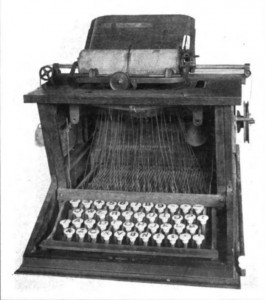It’s a world where anything is possible. One day, you win an Oscar for your dissertation on the hidden substance of bonbons vis-à-vis Schrödinger’s cat; the next, you bring your fascination with old-timey mechanical doodads to a primed-and-ready steampunk-crazed consumer base with iPads. God bless you, Tom Hanks, for all that you do.
In all fairness, Hanx Writer is pretty cute. The Five-Timer Club member and famed typewriter collector recently joined forces with what we have to assume is one or more developers (unless he’s coding now (!)) to translate his typewriter love-fest into a language that both kids and adults understand. It’s inedible Frosted Mini-Wheats, basically.
The mega-popular Hanx Writer — the number one free app in the App Store as of today — takes ordinary word processing functionality and dresses it up with the atavistic mechanical sounds, Courier font, and animated type guide that recalls a time when writing meant something. Sean Connery’s William Forrester would be proud.
Hanks himself understands that his app isn’t ideal for term papers or legal briefs, but envisions it more for journal entries, love letters, and the like. His eyesight seems to be working just fine. We can all truly be the man now, dog. From Mashable: http://mashable.com/2014/08/18/tom-hanks-typewriter-app/.



 Taking all of this into consideration, one must wonder if another music streaming service is necessary and profitable. Beats Electronics seems to think so, as the company behind the popular line of high-end headphones and speakers, launched Beats Music earlier this week. Creators record producer Jimmy Iovine and rapper Dr. Dre. Iovine, are optimistic about Beats Music’s ability to compete in the marketplace because of the instant brand recognition and cross promotion opportunities through the already successful Beats headphones. “Beats will draw a lot of attention to music services, creating a halo effect for the industry,” says Ted Cohen, managing partner with digital music consultant Tag Strategic. The service will be available on both Apple iOS and Android devices, and features a combination of abilities that other service providers have like on-demand tunes similar to Spotify and the music suggestions and curated playlists available with Pandora and Songza. It also boasts an on-demand library of more than 20 million songs. Beats real competitive advantage will come from its fixed fee subscription model like Netflix. “Subscription can really work. It can be great, if not better than owning the music, because you have all the music to choose from.” —Beats Music co-founder Iovine
Taking all of this into consideration, one must wonder if another music streaming service is necessary and profitable. Beats Electronics seems to think so, as the company behind the popular line of high-end headphones and speakers, launched Beats Music earlier this week. Creators record producer Jimmy Iovine and rapper Dr. Dre. Iovine, are optimistic about Beats Music’s ability to compete in the marketplace because of the instant brand recognition and cross promotion opportunities through the already successful Beats headphones. “Beats will draw a lot of attention to music services, creating a halo effect for the industry,” says Ted Cohen, managing partner with digital music consultant Tag Strategic. The service will be available on both Apple iOS and Android devices, and features a combination of abilities that other service providers have like on-demand tunes similar to Spotify and the music suggestions and curated playlists available with Pandora and Songza. It also boasts an on-demand library of more than 20 million songs. Beats real competitive advantage will come from its fixed fee subscription model like Netflix. “Subscription can really work. It can be great, if not better than owning the music, because you have all the music to choose from.” —Beats Music co-founder Iovine